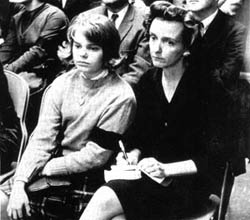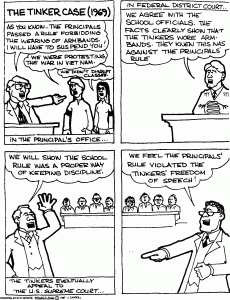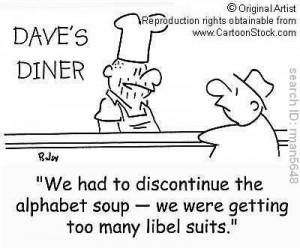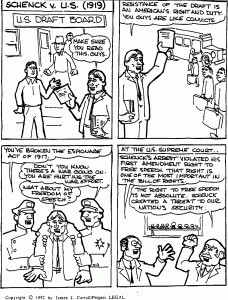
Mary Beth Tinker and her mother
Facts: As we finish discussing the first amendment and begin analyzing student speech, it seems fitting to look at a case that combines both: Tinker v. Des Moines Independent Community School Dist. 393 u.s. 503 (1969). John F. Tinker and Christopher Eckhardt went to high school in Des Moines, Iowa. Mary Beth Tinker attended middle school. In 1965, a group of the students and adults decided to support Kennedy’s Christmas truce and protest the Vietnam War by wearing black armbands, as several groups had done before. The principals of the school found out the plans and quickly devised a policy that students who wore black armbands would be asked to remove them, and suspended if they did not comply, unless they would remove the armbands. Well, John, Mary Beth and Christopher wore thier black armbands and were suspended. They returned to the school after the new year, the time they had set to conclude their Vietnam War protest. For more background, and to see an interview with the one and only Mary Beth Tinker, check out this video!

If you can read the cartoon to the right, you will find that although the students ended the protest, they (especially their parents) took the case to court in order to maintain their first amendment rights. Eventually, the case made its’ way to the Supreme Court. Here is the progression of appeal that the angry parents and students made:
- The Tinker’s first stop was the District Court. The Court, after an evidentary (preliminary) hearing, upheld the constitutionality of the school officials’ actions as reasonable, because they were acting to prevent disturbance of discipline in the school.
- The complaint then showed up at the Court of Appeals for the Eighth Circuit, which affirmed the District Court’s decision without opinion.
- Finally, the case reached the Supreme Court.
Legal Issue: So what was the court trying to decide? Well, in the words of Justice Fortas, who delivered the court opinion, the problem was deciding, “where students in the exercise of their first amendment rights collide with the rules of the school authorities.” Basically, was it constitutional for the school authorities to invoke a suspension on the students who were manifesting their freedom of passive protest by wearing the black armbands? The court had to decide how much power the school officials had in the Tinker case, before the school infringed upon the first amendment rights of the students.
Decision: The court ruled 7-2 in favor of Tinker, reversing and remanding the previous decisions of the lower courts.
In our system, state-operated schools may not be enclaves of totalitarianism. School officials do not possess absolute authority over their students. Students in school as well as out of school are ‘persons’ under our Constitution. They are possessed of fundamental rights which the State must respect, just as they themselves must respect their obligations to the State.
Analysis: The court firmly stated that the classroom is the “marketplace of ideas,” as stated in Shelton v. Tucker, and it is crucial to keep the freedom readily available. The school authorities were clearly trying to avoid disturbence in the school from the controversy, not by wearing the armbands, but what the armbands made students consider, the coversation about the legitimacy of the Vietnam War.
The opinion stated:
But, in our system, undifferentiated fear or apprehension of disturbance is not enough to overcome the right to freedom of expression. Any departure from absolute regimentation may cause trouble. Any variation from the majority’s opinion may inspire fear. Any word spoken, in class, in the lunchroom, or on the campus, that deviates from the views of another person may start an argument or cause a disturbance. But our Constitution says we must take this risk.
Furthermore, only five students of the 18,000 students were suspended for refusing to take off their armbands! Similarly, while banning the armbands would be a less obvious disregard of first amendment rights than say, if students were banned about talking about the Vietnam war in class, the ban is still infringing upon the first amendment rights of “pure speech” as Justice Fortas said. The opinion states why the armbands are permissible:
Freedom of expression would not truly exist if the right could be exercised only in an area that a benevolent government has provided as a safe haven for crackpots. The Constitution says that Congress (and the States) may not abridge the right to free speech. This provision means what it says. We properly read it to permit reasonable regulation of speech-connected activities in carefully restricted circumstances. But we do not confine the permissible exercise of First Amendment rights to a telephone booth or the four corners of a pamphlet, or to supervised and ordained discussion in a school classroom.
Finally, and perhaps most interesting, the school officials only banned the black armbands, not other items like the Iron Cross (a symbol of Nazism).
In a dissenting opinion, Justice Black said that students a reflection of their parents’ ideals, thus do not neccessarily need the extensive freedom of speech that adults have. Also, he said that the black armbands did indeed cause the disruption that the school officials so feared.
I think the record overwhelmingly shows that the armbands did exactly what the elected school officials and principals foresaw they would, that is, took the students’ minds off their classwork and diverted them to thoughts about the highly emotional subject of the Vietnam war.
Questions:
- Do you think the court made the right decision about declaring the suspension unconstitutional?
- Do you think the dissenting opinion by Justice Black holds any weight?
- What is the significance of this case in light of student speech?
- Did the time period in history affect the school officials’ response to the symbolic protest? (remember: Kennedy had declared a Christmas truce)
- Fact: This regulation was a response to a student asking a journalist teacher to publish a story about Vietnam in the paper. The student was rejected. How has this changed today?



